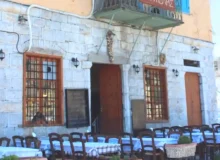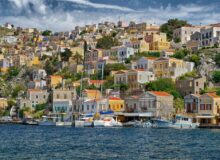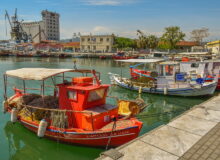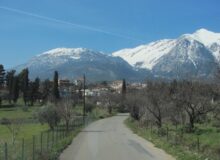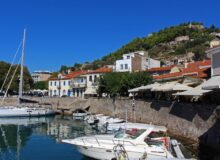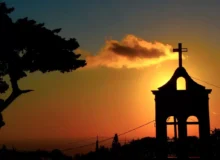The See Greece guide to the island of Andros in the Cyclades, with a brief history and travel information on how to get there and what to see and do.

Introduction
Andros is the northernmost island of the Cyclades and one of the most enchanting destinations in Greece. Known for its lush landscapes, pristine beaches, Venetian architecture, and rich maritime history, Andros offers a unique blend of natural beauty and cultural heritage. Unlike many other Cycladic islands, Andros is verdant, with flowing streams, waterfalls, and fertile valleys, making it a paradise for hikers and nature lovers.
Where is Andros Located?
Andros is part of the Cyclades island group in the Aegean Sea. It lies approximately 10 km southeast of Euboea (Evia) and about 90 km east of Athens. The island is roughly 40 km long and 16 km wide, making it the second-largest Cycladic island after Naxos.
Its strategic position has made it an important maritime hub throughout history, and its proximity to Athens makes it an ideal getaway for both Greeks and international travelers.

A Brief History of Andros
Andros has a rich history dating back to ancient times. Here’s a brief overview:
Ancient Times
– Andros was inhabited since prehistoric times, with evidence of settlements from the Neolithic period.
– In ancient Greek mythology, the island was named after Andros, the grandson of Apollo.
– It was an important maritime power in antiquity, known for its sailors and trade.
– The island was a member of the Delian League (led by Athens) and later came under Macedonian and Roman rule.
Byzantine & Venetian Era
– During the Byzantine period, Andros became a center of Christianity, with many churches and monasteries built.
– In 1207, the island was conquered by the Venetians, who constructed fortresses and towers to defend against pirates. The capital, Chora (Andros Town), still retains Venetian architecture.
Ottoman Rule & Modern Era
– The Ottomans ruled Andros from 1566 to 1821, though the island enjoyed some autonomy due to its strong naval tradition.
– Andros played a significant role in the Greek War of Independence (1821) and became part of the modern Greek state.
– In the 19th and 20th centuries, Andros became wealthy from its shipping industry, with many shipowners building grand mansions on the island.
Today, Andros is a peaceful, sophisticated island that attracts visitors with its natural beauty, hiking trails, and cultural attractions.

What to See & Do on Andros
1. Explore Andros Town (Chora)
The island’s capital is a stunning mix of Venetian, neoclassical, and Cycladic architecture. Highlights include:
– The Castle of Andros (Mesa Kastro) – A Venetian fortress offering panoramic views.
– Archaeological Museum – Showcasing finds from ancient Andros.
– Museum of Contemporary Art – Founded by the Basil & Elise Goulandris Foundation, featuring works by Picasso, Matisse, and Greek artists.
– Riva Square – A lively waterfront area with cafes and restaurants.
2. Visit Batsi – The Most Popular Resort
Batsi is a charming coastal village with:
– A sandy beach with crystal-clear waters.
– Traditional tavernas and bars.
– A picturesque harbor perfect for sunset views.

3. Discover Andros’ Best Beaches
Andros has both organized and secluded beaches:
– Achla Beach – A hidden gem with turquoise waters, accessible by boat or a rough road.
– Golden Sand (Chryssi Ammos) – A long, sandy beach with shallow waters.
– Vitali Beach – A pebbly, secluded beach ideal for snorkeling.
– Zorkos Beach – A wild, unspoiled beach with dramatic cliffs.
4. Hike the Andros Routes (One of the Best Hiking Networks in Greece)
Andros has over 300 km of marked hiking trails, including:
– Pithara Waterfalls – A lush trail leading to a stunning waterfall.
– Chora to Apikia (via the Sariza Spring) – A scenic route with natural springs.
– Menites to Stenies – A path through olive groves and stone bridges.
5. Visit the Monasteries & Churches
– Panachrantos Monastery – A historic 10th-century monastery with breathtaking views.
– Agia Irini Monastery – A peaceful retreat with a small museum.
– Taxiarchis Church (Mesa Chorio) – A beautiful Byzantine-era church.
6. Explore the Traditional Villages
– Paleopolis – The ancient capital with archaeological ruins.
– Menites – Famous for its natural springs and lush greenery.
– Stenies – A picturesque village with shipowners’ mansions.
7. Enjoy Local Cuisine
Andros is known for its delicious food, including:
– Frutalia (Andriot omelette with potatoes and sausage).
– Kaltsounia (cheese or herb pies).
– Ladenia (local pizza-like dish).
– Fresh seafood and local wines.

How to Get to Andros
By Ferry
The most common way to reach Andros is by ferry from Rafina (near Athens) or other Cycladic islands.
From Rafina to Andros (Gavrio Port)
– Duration: 2 hours (conventional ferry) or 1 hour (high-speed).
– Operators: Golden Star Ferries, Fast Ferries, SeaJets.
– Frequency: Daily departures, more frequent in summer.
From Other Islands (Tinos, Mykonos, Syros)
– Andros is connected to Tinos (1.5 hrs), Mykonos (2.5 hrs), and Syros (3 hrs) via ferry.
By Air
Andros does not have an international airport. The closest options are:
1. Athens International Airport (ATH) – Fly into Athens, then take a bus/taxi to Rafina port (45 min) and a ferry to Andros.
2. Mykonos Airport (JMK) – Fly to Mykonos, then take a ferry to Andros (2.5 hrs).

Getting Around Andros
– Car/Bike Rental – Recommended for exploring remote beaches and villages.
– Local Buses – Limited but connect main towns (Chora, Batsi, Gavrio).
– Taxis – Available but can be expensive for long distances.

Final Tips for Visiting Andros
– Best Time to Visit: May-October (July-August is peak season).
– Packing Tips: Comfortable shoes for hiking, swimwear, and light layers.
– Language: Greek, but English is widely spoken in tourist areas.
– Currency: Euro (€).















